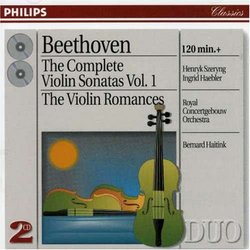| All Artists: Ludwig van Beethoven, Bernard Haitink, Royal Concertgebouw Orchestra, Ingrid Haebler Title: Beethoven: The Complete Violin Sonatas, Vol. 1 Members Wishing: 0 Total Copies: 0 Label: Philips Release Date: 1/23/1996 Genre: Classical Styles: Chamber Music, Forms & Genres, Concertos, Historical Periods, Classical (c.1770-1830), Instruments, Strings Number of Discs: 2 SwapaCD Credits: 2 UPC: 028944652123 |
Search - Ludwig van Beethoven, Bernard Haitink, Royal Concertgebouw Orchestra :: Beethoven: The Complete Violin Sonatas, Vol. 1
 | Ludwig van Beethoven, Bernard Haitink, Royal Concertgebouw Orchestra Beethoven: The Complete Violin Sonatas, Vol. 1 Genre: Classical
|
Larger Image |
CD Details |
CD ReviewsBeethoven's Early Sonatas for Piano and Violin Robin Friedman | Washington, D.C. United States | 12/18/2003 (5 out of 5 stars) "Beethoven wrote ten sonatas for piano and violin, the best known of which are the "Spring" and the "Kreutzer" sonatas. The fame of these two works has tended to result in neglect of the remaining sonatas. This is unfortunate because Beethoven's remaining eight sonatas for piano and violin include much great music. The set of 10 works is of an appropriate size to warrant exploration of the entire group for those with a passion for the violin or for Beethoven. It includes an appealing mix of familiar and unfamiliar music.This 2-CD disc includes the first five of Beethoven's sonatas in this genre played by violinist Henryk Szeryng and pianist Ingrid Haebler. They are all early works and will reward listening. Beethoven composed his first violin and piano sonatas in 1797-1798 when he was 27 and published them in a three-work set as his opus 12. The works are in D-major, A-major, and E-flat major and each consists of three movements. The D-major sonata's opening movement features a wealth of themes which follow rapidly on one another. It is lively and exuberant, beginning with the loud chords with which it opens. The second movement is a theme and variations, which foreshadows Beethoven's use of this form in the slow movement of the Kreutzer sonata. The A-major sonata opens with a humorous, boisterous first movement followed by a surprisingly poignant slow movement. The E-flat major sonata too has an expressive slow movement. The first movement features long brilliant downward runs in the piano with the violin accompanying on top. The third movement of each of these works is a lively rondo. Although this music is delightful to modern listeners, a contemporary reviewer criticized these works as difficult to hear. "Learned, learned, always learned" he complained, "no naturalness, no melody!"The next two sonatas, opus 23 and opus 24 appear to have been written as a contrasting pair. The three-movement opus 23 sonata in A-minor is, in my view, a neglected masterpiece. This is a spare, linear and angry work. It is in 6/8 time and opens with a sharp theme introduced by the piano followed by a softer middle movement, and intensely lyrical writing for the violin in the development. The second movement opens with a halting, reflective theme stated by the piano with the violin on top followed by a quicker, fugal section. The final movement returns to the intensity of the first movement with the violin melody over repeated tremolos in the piano. Large chords in the piano under the violin lead to a quiet close. This outstanding work is similar in many ways to the better-known "Kreutzer" sonata.The final sonata on this disc is the "Spring" sonata, in F-major opus 24 which has always been Beethoven's most beloved work in this form. The sonata is in four movements and is lyrical throughout. The first movement features a singing, extended melody which has given the work its nickname. The second movement features a more intense lyricism which foreshadows Schubert for many listeners. The third movement is a brief, rhythmically complex scherzo and the finale returns to the long lyrical line of the opening movement.This disc also includes Beethoven's two early Romances for violin and orchestra played by Szeryng and the Royal Concertgebourw Orchestra conducted by Bernard Haitink. These are probably early works and may have been intended as the slow movement for a violin concerto.Szeryng and Haebler offer wonderful renditions of this music. The piano and the violin are balanced and play as equals, as Beethoven intended, with neither instrument trying to overshadow the other. Szeryng plays with a rich tone that comes through beatifully in the "Spring" sonata. The "Spring" is taken at a slower tempo than is sometimes the case. The recordings on this compilation date from 1978 and the CD sells at a reasonable price.This disc, and its companion disc of the later five sonatas, constitute an excellent compliation of Beethoven's piano and violin music. They are an excellent way for the listener to become acquainted with these works."
|

 Track Listings (9) - Disc #1
Track Listings (9) - Disc #1